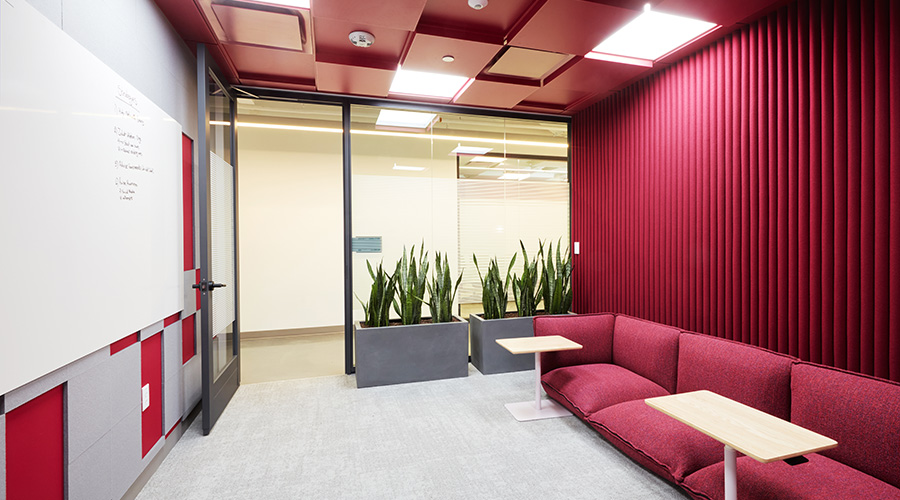All Business
Within T. Rowe Price’s boardroom, Carol Blanar's no-nonsense approach wins respect for facility issues. But in the company’s offices and hallways, good business takes on another aspect: listening to occupant concerns
Carol Blanar’s career at T. Rowe Price Group is heading full circle.
Blanar, director of facilities for the global investment management firm, says she got a job with the company in part because of one line on her resume.
“My resume said I had just helped a company move an office,” she says. “At the time, T. Rowe was looking at expanding its facilities and needed an administrative person to help.”
Now, 17 years and a few promotions later, she finds herself in a similar position. This time it’s going to take more than a line on a resume.
Blanar is part of a T. Rowe working group that is deciding whether the firm that manages nearly $169 billion in assets for investors worldwide should stay in downtown Baltimore or move to a campus setting in the suburbs. It’s a decision that will involve more people than just Blanar, to be sure. Yet, she is being looked at to supply an essential understanding of how facilities can function to satisfy T. Rowe’s employees while meeting the business’ mission and needs.
It’s a task for which she has spent a career cultivating the necessary skills.
Blanar didn’t get to be responsible for T. Rowe’s 1.3 million square feet of facility space just by mastering the intricacies of building automation systems or daylighting dimming schemes. She got there through a firm understanding of return on investment, asset management, accounting and other financial concepts.
Finding Balance
That’s not to say Blanar doesn’t understand what it takes to make a facility comfortable and efficient. She prides herself on her ability to understand occupant concerns and her staffs’ ability to understand what systems need adjusting or changing to address such issues. It’s just that she developed a broader understanding of the business sense necessary to make facilities function appropriately for the organization.
“I think I have an advantage over those with a formal degree in facility management or those who grew up through the engineering ranks,” says Blanar, who earned her degree in business from the University of Baltimore. “I think I’m better able to understand how the senior management group sees facilities. In this day and age, you need a strong business background to be able to interact with senior management and the heads of other business units.”
Blanar characterizes her career by her ability to see to the facility needs of T. Rowe’s 3,700 employees without losing sight of the organization’s boardroom. She works closely with the firm’s chief financial officer and director of financial planning on identifying facility stacking needs and plans. Meanwhile, however, she remains rooted in knowing what occupants want from facilities.
“Carol works in both worlds simultaneously,” says Tim Fox, T. Rowe’s director of financial planning. “Because of her business acumen, she can go places and offer a perspective that no one else can.”
Facilities as a Business Tool
Facilities have become increasingly important to T. Rowe since Blanar joined the firm. When Blanar started, the company occupied approximately 168,000 square feet of a 365,000-square-foot building. Her responsibilities dealt as much with purchasing as they did with facilities services.
Now, she heads up three distinct areas of facilities — planning and design, mail communications, and facility management services — comprised of 52 in-house employees. She is expected to deliver facilities that can help recruit and retain employees while accommodating the organization’s growth.
Fox says T. Rowe views facilities as an important component of the company’s ability to attract talent out of colleges. That’s part of the reason why the company built a 33-acre campus in Owings Mills, Md., with certain amenities, such as volleyball courts and full-service cafeterias, to match facilities to the needs of the work force. The company has discovered that things like free parking and a pastoral setting are important to the people it hires. It even incorporates as many of those amenities as possible into leased buildings.
“We want to make sure there is that T. Rowe feeling, that T. Rowe look,” he says. “One way is to do that through facilities.”
When T. Rowe built the Owings Mills campus, Blanar says, planners made a special effort to preserve as many trees as they could and to incorporate the environment into the campus landscaping.
“That meant a lot to our associates who appreciate the environment,” she says.
For those with other interests — like minimizing the amount of time they have to spend in the rain — Blanar and the design team worked to reduce the distance between the parking garage and building entrances. The furthest anyone has to walk from a vehicle is 700 feet.
T. Rowe built the campus at a time its business experienced rapid growth. In the late ’80s and early ’90s, the amount of money investors poured into mutual funds grew. Companies were abandoning traditional pension plans in favor of 401k retirement plans, increasing business for the mutual fund investment industry.
T. Rowe constructed the four-building campus to accommodate the expanded need for support services that the new book of business required. Fox says the company has always had people to handle shareholder investments, but needed facility space to provide servicing for its retail and institutional customers.
As the campus was being built, Blanar was key in deciding the facility plan. Knowing what business functions should be located where within the campus is a facet of facility planning in which Blanar shines, says T. Rowe’s former chief financial officer, who worked with Blanar for many years before leaving late last year.
Blanar has a good sense of knowing what business units should be located near one another, the former CFO says. Blanar’s business background gives her a good sense of certain efficiencies that can be created by the careful placement of business units. “Frankly, she’s better at it than most others I’ve seen,” the former CFO says.
Part of the reason Blanar is so good at understanding the optimum locations for certain business units is because she’s adept at finding out what occupants want. The former CFO says T. Rowe has a fairly collegial culture that grew out of the company’s beginnings as a partnership. Some of the business unit leaders have been around for nearly two decades or longer.
During that time, she’s developed good relationships with unit leaders. What she has to be careful of, however, is being sure those leaders know what they need to know about facilities without delving into the minutiae of facility management. Delving into the details of the differences between useable square feet and rentable square feet, for example, would lose a lot of people quickly.
For Blanar, it’s important to keep the attention of occupants. A significant part of her role with the working group investigating T. Rowe’s future facility plan is to find out what occupants think.
“I look at myself as the one that will represent the needs of the users,” Blanar says. “It’s not a role I take lightly.”
Rather than sending out surveys to gauge occupant opinions, Blanar relies on face-to-face communication. She meets with business unit leaders. She talks with IT personnel to find out their requirements for a new building. She interacts with others on the working group.
“Having somebody like Carol who is very people savvy is a positive,” the former CFO says. “She’s definitely one of those people who manages by walking around.”
Blanar says her method is just the way she’s always conducted business.
“You learn a lot when you can see people in their corner — in their space,” she says. “Body language can tell you a lot.”
T. Rowe outsources day-to-day facility functions and maintenance, allowing Blanar and her facility team to focus on issues of strategic importance to the organization. She places a high value on maintaining relationships with the organization’s vendors and relies on them to operate important aspects of the organization’s business.
The data center, for example, is monitored by an outside firm, as are all T. Rowe Price’s critical sites. If there are problems in any of those facilities, Blanar says, she gets notified and can check up with her team to be sure the problems are rectified.
‘Small’ Issues Matter
Not all of the problems that occur at facilities, however, can be fixed by outside firms. There are certain situations in which Blanar must get involved. One of the more unusual situations occurred when T. Rowe Price was building its call center in Colorado Springs. As the finishing touches were being put on the campus master plan, the Army Corps of Engineers notified her that the planned construction would endanger the habitat of the Preble mouse.
The mouse, about 9 inches in length, lives along the foothills of southeastern Wyoming, stretching south to Colorado Springs. But it was the mouse’s designation as an endangered species that created the most concern for Blanar. Its discovery in the area of T. Rowe’s planned construction forced the company to draft a plan of how it would rebuild the mouse’s habitat.
“It was quite the conversation around the tables,” she says.
That was also the facility where Blanar had to speak with the owner of a neighboring golf course. Apparently, more than one golfer at the course had a horrendous slice that was putting golf balls squarely onto the roofs and into the fenders and windshields of cars parked on the top level of a parking garage.
The golf course owner agreed that a line of trees between the course and the parking garage was in order.
On more serious matters, Blanar has worked with the chief financial officer on business continuity planning. Most recently, the two discussed how T. Rowe would react to the threat of Hurricane Isabel, which hit the coast in September.
Although Baltimore escaped the brunt of the storm’s fury, there was flooding in the downtown area that forced T. Rowe to relocate its first-floor operations to higher — and drier — ground. The necessary relocations were complete before the storm hit.
“It showed us how good plans and a good foundation to planning can pay off,” Blanar says.
Planning for Tomorrow
Blanar and others at T. Rowe undertook a good bit of continuity planning in the wake of the terrorist attacks on Sept. 11. Although she doesn’t consider the T. Rowe buildings a terrorist target, Blanar and her staff did plan for what would happen if buildings in the area were targeted.
The headquarters building is located between the Federal Reserve Bank of Baltimore and the Baltimore World Trade Center. The Sept. 11 tragedy also gave the firm first-hand knowledge of how investors react when the nation’s economic symbols are attacked.
Call centers in Baltimore, Colorado Springs, Colo., and Tampa, Fla., experienced unusual call volume in the days and weeks following the attacks, Blanar says. “We learned people use the phones a lot more to check on their investments,” she says.
Blanar’s concerns today are far different than when she started at T. Rowe in the 1980s. One of the company’s latest efforts to serve its clients puts her in the midst of managing retail outlets where customers can visit one-on-one with T. Rowe investment managers. The Investor Centers, located nationwide, allow T. Rowe clients to conduct research, open accounts and discuss financial planning with advisers.
With each change in business focus, Blanar has a new opportunity to apply her business knowledge to facility needs. There might have been a time when the need to understand depreciation, amortization and the effect of facility expenditures on a company’s profitability wasn’t as great as it is now. But for anyone entering facility management today, Blanar says she doesn’t see any way around knowing the business side of facilities.
“I think there has to be a balance in facilities today because they occupy a significant place on the bottom line,” she says.
It’s tough to argue that with somebody who has spent a career balancing business goals with facility technology issues.
Related Topics:











